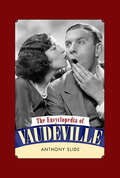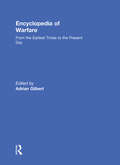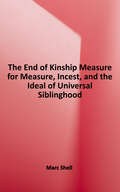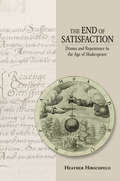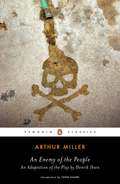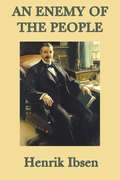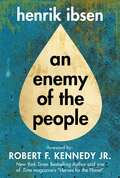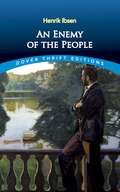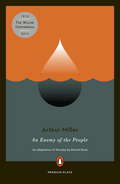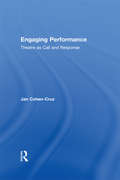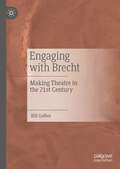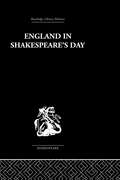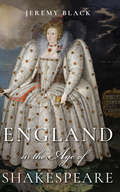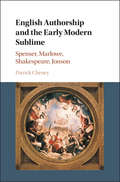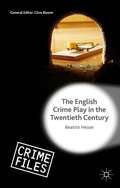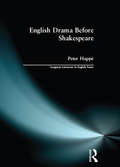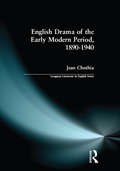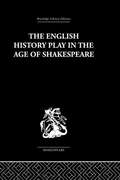- Table View
- List View
The Encyclopedia of Vaudeville
by Anthony SlideThe Encyclopedia of Vaudeville provides a unique record of what was once America's preeminent form of popular entertainment from the late 1800s through the early 1930s. It includes entries not only on the entertainers themselves, but also on those who worked behind the scenes, the theatres, genres, and historical terms. Entries on individual vaudevillians include biographical information, samplings of routines and, often, commentary by the performers. Many former vaudevillians were interviewed for the book, including Milton Berle, Block and Sully, Kitty Doner, Fifi D'Orsay, Nick Lucas, Ken Murray, Fayard Nicholas, Olga Petrova, Rose Marie, Arthur Tracy, and Rudy Vallee. Where appropriate, entries also include bibliographies. The volume concludes with a guide to vaudeville resources and a general bibliography. Aside from its reference value, with its more than five hundred entries, The Encyclopedia of Vaudeville discusses the careers of the famous and the forgotten. Many of the vaudevillians here, including Jack Benny, George Burns and Gracie Allen, Jimmy Durante, W. C. Fields, Bert Lahr, and Mae West, are familiar names today, thanks to their continuing careers on screen. At the same time, and given equal coverage, are forgotten acts: legendary female impersonators Bert Savoy and Jay Brennan, the vulgar Eva Tanguay with her billing as “The I Don't Care Girl,” male impersonator Kitty Doner, and a host of “freak” acts.
Encyclopedia of Warfare: From the Earliest Times to the Present Day
by Adrian GilbertThe Encyclopedia of Warfare is a chronological account of the development of warfare since the beginnings of recorded history. The book is organized in 10 chapters, each of which looks at a particular era in warfare from the ancient world to the present. Each chapter includes color maps of key campaigns, as well as commentary on battles, personalities, troops, and equipment. Sidebars throughout the main narrative focus on noteworthy aspects of the history of conflict. Through its chronological organization and ample use of maps, the Encyclopedia also clearly conveys the link between war and world geographical history. A thorough yet concise exploration of combat throughout human history, this fascinating and informative reference work is an outstanding addition to any library collection.
The End of Kinship: "Measure for Measure", Incest, and the Ideal of Universal Siblinghood
by Marc ShellIn this provocative commentary on Shakespeare's Measure for Measure, Marc Shell focuses on the play's basic themes of sexual extremism, exchange, and political order. At the crux of the play, he notes, the novice nun Isabella accuses her brother Claudio: "Is't not a kind of incest, to take life/From thine own sister's shame?" Shell's analysis shows exactly how Claudio's request is a kind of incest in a virtuoso analysis that extends his earlier work on philosophical and literary economies. In the first work to develop fully the thematic role of the monastic orders in Shakespeare's drama, Shell demonstrates that the play lays bare some of Western culture's most fundamental tensions -- between natural and political teleologies, between Christian and political ideals of brotherhood and the incest taboo, and between the pragmatic imperative to classify people and the moral imperative to treat them all alike. Drawing upon an astonishing range of literary material, Shell's discussion goes far beyond mere commentary -- offering, for example, brilliant readings of other Shakespearean plays. Praise for Marc Shell's The Economy of Literature and Money, Language, and Thought, also published by Johns Hopkins: "Shell offers admirably close readings [which are] often brilliant." -- The Eighteenth Century "A remarkable piece of work. Valuable for a wide range of readers from the expert to the inquiring generalist." -- Religious Studies Review "Stimulating and valuable." -- Comparative Literature
The End of Satisfaction: Drama and Repentance in the Age of Shakespeare
by Heather HirschfeldIn The End of Satisfaction, Heather Hirschfeld recovers the historical specificity and the conceptual vigor of the term “satisfaction” during the sixteenth and early seventeenth centuries. Focusing on the term’s significance as an organizing principle of Christian repentance, she examines the ways in which Shakespeare and his contemporaries dramatized the consequences of its re- or de-valuation in the process of Reformation doctrinal change. The Protestant theology of repentance, Hirschfeld suggests, underwrote a variety of theatrical plots “to set things right” in a world shorn of the prospect of “making enough” (satisfacere).Hirschfeld’s semantic history traces today’s use of “satisfaction”—as an unexamined measure of inward gratification rather than a finely nuanced standard of relational exchange—to the pressures on legal, economic, and marital discourses wrought by the Protestant rejection of the Catholic sacrament of penance (contrition, confession, satisfaction) and represented imaginatively on the stage. In so doing, it offers fresh readings of the penitential economies of canonical plays including Dr. Faustus, The Revenger’s Tragedy, The Merchant of Venice, and Othello; considers the doctrinal and generic importance of lesser-known plays including Enough Is as Good as a Feast and Love’s Pilgrimage; and opens new avenues into the study of literature and repentance in early modern England.
Un enemigo del pueblo
by Henrik Ibsen"Nunca debe usted usar sus mejores pantalones cuando vaya a luchar por la libertad y la verdad" (Un enemigo del pueblo) Henrik Ibsen creó una obra dramática de enorme contenido psicológico y de una ideología profunda. Fue un iniciador en el arte dramático y representante de una época nueva siendo el creador del llamado "teatro de ideas" y del "teatro simbólico". Lla obra de Ibsen se puede considerar como la más influyente del siglo XX en el campo del drama. Sus trabajos se representan continuamente en los países civilizados y se han adaptado al cine y a la televisión innumerables veces.
An Enemy of the People
by John Guare Arthur MillerWhen Dr. Stockmann discovers that the water in the small Norwegian town in which he is the resident physician has been contaminated, he does what any responsible citizen would do: reports it to the authorities. But Stockmann's good deed has the potential to ruin the town's reputation as a popular spa destination, and instead of being hailed as a hero, Stockmann is labeled an enemy of the people. Arthur Miller's adaptation of Henrik Ibsen's classic drama is a classic in itself, a penetrating exploration of what happens when the truth comes up against the will of the majority. This edition includes Arthur Miller's preface and an introduction by John Guare.For more than seventy years, Penguin has been the leading publisher of classic literature in the English-speaking world. With more than 1,700 titles, Penguin Classics represents a global bookshelf of the best works throughout history and across genres and disciplines. Readers trust the series to provide authoritative texts enhanced by introductions and notes by distinguished scholars and contemporary authors, as well as up-to-date translations by award-winning translators.From the Trade Paperback edition.
An Enemy of the People
by Henrick IbsenAn Enemy of the People addresses the irrational tendencies of the masses, and the hypocritical and corrupt nature of the political system that they support. It is the story of one brave man's struggle to do the right thing and speak the truth in the face of extreme social intolerance.
Enemy of the People: A Play In Five Acts
by Henrik IbsenEnvironmentalist, activist, and attorney Robert F. Kennedy Jr. contributes a foreword to this Skyhorse edition of Norwegian playwright Henrik Ibsen&’s renowned 1882 play. Regarded as one of the foremost playwrights of the nineteenth century, Henrik Ibsen tells the story of the idealist Doctor Thomas Stockmann, the medical officer of a recently opened spa in a small town in southern Norway, who finds that the water is seriously contaminated. He notifies members of the community and initially receives support and thanks for the discovery. Threatened by the possible impact of such a revelation, his brother, the town mayor, conspires with local politicians and the newspaper to suppress the story and pressure Dr. Stockmann to retract his statements. At a public meeting, an attempt is made to keep Dr. Stockmann from speaking, but he launches into a tirade condemning the corruption of the town and the tyranny of the majority. Finding his speech offensive, he is shouted down by the masses and reviled as "an enemy of the people." In his foreword, Kennedy alerts readers to the undeniable fact that the persecution of those who tell uncomfortable truths, which Ibsen described over one hundred years ago, continues to this day and is as relevant now as ever. We face environmental deregulation and degradation, politicians in lobbyists&’ pockets, attacks on facts that are agreed upon by reputable scientists, corporate funded and controlled research, and attempts to impede and suppress whistleblowers. The battle continues and Kennedy joins Ibsen on the front lines.
An Enemy of the People: A Play In Five Acts (Dover Thrift Editions Ser.)
by Henrik IbsenWidely regarded as one of the foremost dramatists of the nineteenth century, Norwegian playwright Henrik Ibsen (1828-1906) brought the social problems and ideas of his day to center stage. Creating realistic plays of psychological conflict that emphasized character over cunning plots, he frequently inspired critical objections because his dramas deemed the individual more important than the group.In this powerful work, Ibsen places his main characters, Dr. Thomas Stockman, in the role of an enlightened and persecuted minority of one confronting an ignorant, powerful majority. When the physician learns that the famous and financially successful baths in his hometown are contaminated, he insists they be shut down for expensive repairs. For his honesty, he is persecuted, ridiculed, and declared an "enemy of the people" by the townspeople, included some who have been his closest allies.First staged in 1883, An Enemy of the People remains one of the most frequently performed plays by a writer considered by many the "father of modern drama." This easily affordable edition makes available to students, teachers, and general readers a major work by one of the world's great playwrights.
An Enemy of the People
by Henrik Ibsen Arthur Miller<P>When Dr. Stockmann discovers that the water in the small Norwegian town in which he is the resident physician has been contaminated, he does what any responsible citizen would do: reports it to the authorities. <P>But Stockmann's good deed has the potential to ruin the town's reputation as a popular spa destination, and instead of being hailed as a hero, Stockmann is labeled an enemy of the people. <P>Arthur Miller's adaptation of Henrik Ibsen's classic drama is a classic in itself, a penetrating exploration of what happens when the truth comes up against the will of the majority. This edition includes Arthur Miller's preface and an introduction by John Guare.
An Enemy of the People
by Arthur MillerWhen Dr. Stockmann discovers that the water in the small Norwegian town in which he is the resident physician has been contaminated, he does what any responsible citizen would do: reports it to the authorities. But Stockmann's good deed has the potential to ruin the town's reputation as a popular spa destination, and instead of being hailed as a hero, Stockmann is labeled an enemy of the people. Arthur Miller's adaptation of Henrik Ibsen's classic drama is a classic in itself, a penetrating exploration of what happens when the truth comes up against the will of the majority. This edition includes Arthur Miller's preface and an introduction by John Guare. For more than seventy years, Penguin has been the leading publisher of classic literature in the English-speaking world. With more than 1,700 titles, Penguin Classics represents a global bookshelf of the best works throughout history and across genres and disciplines. Readers trust the series to provide authoritative texts enhanced by introductions and notes by distinguished scholars and contemporary authors, as well as up-to-date translations by award-winning translators.
Engaging Performance: Theatre as call and response
by Jan Cohen-CruzEngaging Performance: Theatre as Call and Response presents a combined analysis and workbook to examine "socially engaged performance." It offers a range of key practical approaches, exercises, and principles for using performance to engage in a variety of social and artistic projects. Author Jan Cohen-Cruz draws on a career of groundbreaking research and work within the fields of political, applied, and community theatre to explore the impact of how differing genres of theatre respond to social "calls." Areas highlighted include: playwrighting and the engaged artist theatre of the oppressed performance as testimonial the place of engaged art in cultural organizing the use of local resources in engaged art revitalizing cities and neighborhoods through engaged performance training of the engaged artist. Cohen-Cruz also draws on the work of major theoreticians, including Bertolt Brecht, Augusto Boal, and Doreen Massey, as well as analyzing in-depth case studies of the work of US practitioners today to illustrate engaged performance in action. Jan Cohen-Cruz is director of Imagining America: Artists and Scholars in Public Life. She is the author of Local Acts: Community-based Performance in the US; the editor of Radical Street Performance; co-editor, with Mady Schutzman, of Playing Boal: Theatre, Therapy, Activism and A Boal Companion; and a University Professor at Syracuse University.
Engaging with Brecht: Making Theatre in the Twenty-first Century
by Bill GelberThis book makes the case for Bertolt Brecht’s continued importance at a time when events of the 21st century cry out for a studied means of producing theatre for social change. Here is a unique step-by-step process for realizing Brecht’s ways of working onstage using the 2015 Texas Tech University production of Brecht’s Mother Courage and Her Children as a model for exploration. Particular Brecht concepts—the epic, Verfremdung, the Fabel, gestus, historicization, literarization, the “Not…but,” Arrangement, and the Separation of the Elements—are explained and applied to scenes and plays. Brecht’s complicated relationship with Konstantin Stanislavsky is also explored in relation to their separate views on acting. For theatrical practitioners and educators, this volume is a record of pedagogical engagement, an empirical study of Brecht’s work in performance at a higher institution of learning using graduate and undergraduate students.
England in Literature
by Scott ForesmanEngland in Literature has eight chronological units presenting a survey of major British writers from the beginning until the present time.
England in Shakespeare's Day
by G B HarrisonFirst published in 1928. This book collects together over one hundred sources by Elizabethan authors which show English life in English literature. Most of them have been selected as much to catch the atmosphere as the moods of the period, and come from the great Elizabethan writers who can transmit the essence of the time. A 'gallery of Elizabethan pictures' rather than a complete survey of life in Shakespeare's day, the spelling and punctuation have been modernized throughout. To enable those who wish to read the extracts in their context, references are given to the most accessible editions.
England in the Age of Shakespeare
by Jeremy BlackHow did it feel to hear Macbeth’s witches chant of "double, double toil and trouble" at a time when magic and witchcraft were as real as anything science had to offer? How were justice and forgiveness understood by the audience who first watched King Lear; how were love and romance viewed by those who first saw Romeo and Juliet? In England in the Age of Shakespeare, Jeremy Black takes readers on a tour of life in the streets, homes, farms, churches, and palaces of the Bard’s era. Panning from play to audience and back again, Black shows how Shakespeare’s plays would have been experienced and interpreted by those who paid to see them. From the dangers of travel to the indignities of everyday life in teeming London, Black explores the jokes, political and economic references, and small asides that Shakespeare’s audiences would have recognized. These moments of recognition often reflected the audience’s own experiences of what it was to, as Hamlet says, "grunt and sweat under a weary life." Black’s clear and sweeping approach seeks to reclaim Shakespeare from the ivory tower and make the plays’ histories more accessible to the public for whom the plays were always intended.
English Authorship and the Early Modern Sublime: Fictions Of Transport In Spenser, Marlowe, Jonson, And Shakespeare
by Patrick CheneyPatrick Cheney's new book places the sublime at the heart of poems and plays in late sixteenth- and early seventeenth-century England. <P><P>Specifically, Cheney argues for the importance of an 'early modern sublime' to the advent of modern authorship in Spenser, Marlowe, Shakespeare, and Jonson. Chapters feature a model of creative excellence and social liberty that helps explain the greatness of the English Renaissance. Cheney's argument revises the received wisdom, which locates the sublime in the eighteenth-century philosophical 'subject'. <P>The book demonstrates that canonical works like The Faerie Queene and King Lear reinvent sublimity as a new standard of authorship. This standard emerges not only in rational, patriotic paradigms of classical and Christian goodness but also in the eternizing greatness of the author's work: free, heightened, ecstatic. Playing a centralizing role in the advent of modern authorship, the early modern sublime becomes a catalyst in the formation of an English canon.<P> The first book to place the sublime at the heart of poems and plays in late sixteenth- and early seventeenth-century England.<P> Links recent work on the classical or medieval sublime and the modern sublime.<P> Introduces a new model of authorship featuring an aesthetics of sublimity focussing on writers such as Edmund Spenser, Christopher Marlowe, William Shakespeare, and Ben Jonson.
The English Crime Play in the Twentieth Century (Crime Files)
by Beatrix HesseThis is the first comprehensive study of the English crime play, presenting a survey of 250 plays performed in the London West End between 1900 and 2000. The first part is historically orientated while the second one establishes a tentative poetics of the genre. The third part presents an analysis of some 20 plays adapted from detective fiction.
English Drama Before Shakespeare (Longman Literature In English Series)
by Peter HappeEnglish Drama before Shakespeare surveys the range of dramatic activity in English up to 1590. The book challenges the traditional divisions between Medieval and Renaissance literature by showing that there was much continuity throughout this period, in spite of many innovations. The range of dramatic activity includes well-known features such as mystery cycles and the interludes, as well as comedy and tragedy. Para-dramatic activity such as the liturgical drama, royal entries and localised or parish drama is also covered. Many of the plays considered are anonymous, but a coherent, biographical view can be taken of the work of known dramatists such as John Heywood, John Bale, and Christopher Marlowe.Peter Happé's study is based upon close reading of selected plays, especially from the mystery cycles and such Elizabethan works as Thomas Kyd's The Spanish Tragedy. It takes account of contemporary research into dramatic form, performance (including some important recent revivals), dramatic sites and early theatre buildings, and the nature of early dramatic texts. Recent changes in outlook generated by the publication of the written records of early drama form part of the book's focus. There is an extensive bibliography covering social and political background, the lives and works of individual authors, and the development of theatrical ideas through the period. The book is aimed at undergraduates, as well as offering an overview for more advanced students and researchers in drama and in related fields of literature and cultural studies.
English Drama of the Early Modern Period 1890-1940 (Longman Literature In English Series)
by Jean ChothiaThe period 1890-1940 was a particularly rich and influential phase in the development of modern English theatre: the age of Wilde and Shaw and a generation of influential actors and managers from Irving and Terry to Guilgud and Olivier.Jean Chothia's study is in two parts beginning with a portrait of the period, setting the narrative context and considering the dramatic social and cultural changes at work during this time. It then focuses on some of the main themes in the theatre, from Shaw and comedy, to the rise of political and radio drama, providing an interpretative framework for the period. This volume will be of great benefit to students and academics of English literature and drama, as it covers the work of the major dramatists of the period as well as considering the dramatic output of literary figures, such as James, Eliot and Lawrence.
The English History Play in the age of Shakespeare
by Irving Ribner.First published in 1957. This edition re-issues the second edition of 1965. Recognized as one of the leading books in its field, The English History Play in the Age of Shakespeare presents the most comprehensive account available of the English historical drama from its beginning to the closing of the theatres in 1642 and relates this development to Renaissance historiography and Elizabethan political theory.
English Medieval Theatre: 1400–1500 (Routledge Library Editions: Medieval Culture, Society, & Religion)
by William TydemanOriginally published in 1986, this volume illuminates the predominant theatrical styles of a particular period in dramatic history. It does this by reconstructing – as far as conjecture permits – the manner in which five major plays of the late Middle Ages might have been staged in fifteenth-century Britain. The author draws on his experience in producing medieval plays to discuss the business of staging in a novel way. General conclusions are drawn from specific examples and the qualities which give medieval English drama its idiosyncratic features and appeal are characterized.
The English Morality Play: Origins, HIstory, and Influence of a Dramatic Tradition (Routledge Revivals)
by Robert A PotterFirst published in 1975, The English Morality Play is the extended history of the English morality play, its persistence and flourishing as a dramatic tradition. The book sheds light on the intellectual and social origins of the morality play, its relationship to the medieval Corpus Christi cycle plays, its subject, purpose, conditions of original staging, and the abstract characters of its dramatis personae. The changing tradition is revealed within Renaissance drama, in the works of Skelton and Medwall, and the Reformation plays of Lindsay, Bale and Udall, as the morality play altered under the pressure of political events, escaped from the general suppression of religious drama, and in complex ways came to influence the dramatic conceptions of Marlowe, Shakespeare and Ben Jonson. Contemporary parallels to the English morality tradition in European drama are investigated, as is the rediscovery of the texts of the plays by eighteenth- and nineteenth-century critics. In the final chapter, Dr. Potter examines the revival of the morality tradition on the twentieth-century stage and its influence on such dramatists as Bernard Shaw, T. S. Eliot, W. B. Yeats and Bertolt Brecht. This book will be of interest to students of literature and drama.
English Mystery Plays
by Peter HappéHumour, pathos and suffering, and the culminating drama of the Crucifixion and Resurrection, give these plays a wonderful immediacy. Their action was conceived on a cosmic scale and all the enthusiasm and vitality of their writing is retained to this day. The energies of whole communities, notably at Chester, York and Wakefield, were devoted to their production and they were to influence later dramatists significantly. The grand design of the mystery plays was to celebrate the Christian story from 'The Fall of Lucifer' to the 'Judgement Day', and this volume contains thirty-eight plays, forming in itself a composite cycle and including almost all the incidents common to the extant cycles.
English Play Development under Neoliberalism, 2000–2022 (Elements in Contemporary Performance Texts)
by Lucy TylerEnglish Play Development under Neoliberalism, 2000–2022 is the first study of the institutionalising of English play development practices in the twenty-first century. It identifies the ways in which support for playwrights and text development increased beneficially during the 1990s and 2000s. It assesses bureaucratic institutional dynamics in key English producing houses as they were surveyed by two reports in 2009, and how these were experienced and transformed in the 2010s. The Element identifies in new play development innovations in the commodification and marketisation of new writing, the bureaucratisation of literary management, the structuring and restructuring of dramaturgy according to Fordist, then post-Fordist, conditions, and the necessity for commissioned artists to operate as neoliberal subjects. It concludes with attention to a liberatory horizon for play development in the English context. This title is also available as Open Access on Cambridge Core.
